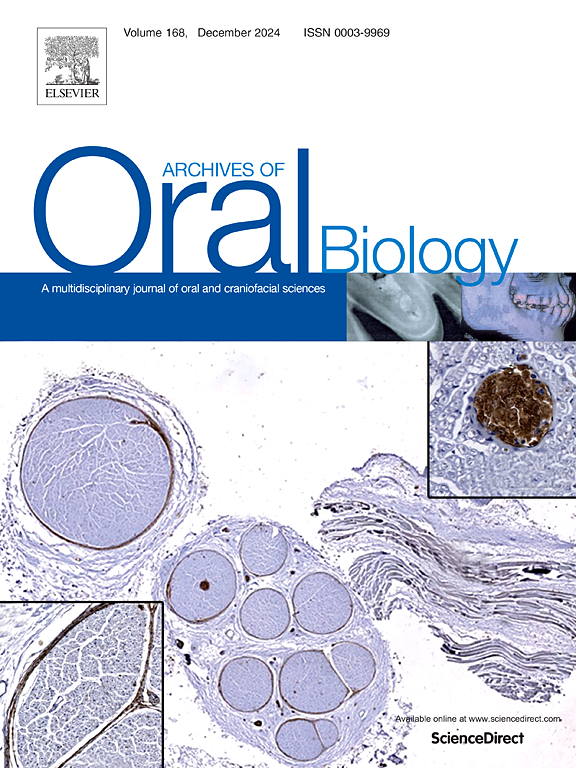Acidic/abrasive challenges on simulated non-carious cervical lesions development and morphology
IF 2.2
4区 医学
Q2 DENTISTRY, ORAL SURGERY & MEDICINE
引用次数: 0
Abstract
Objectives
This in vitro investigation assessed how frequency of erosive challenges and duration of toothbrushing abrasion influenced non-carious cervical lesions (NCCLs) development and morphology. Design: Experimental units were prepared using extracted human premolars assigned to four erosive-abrasive frequency protocols (n=16): F0. No acid exposure (negative control), F2.5 K. Acid exposure (1 % citric acid at natural pH) every 2500, F5K. 5000 and F15K. 15000 brushing-strokes. All groups were brushed for 55000 total brushing-strokes. Three-dimension images of the teeth were captured at baseline, after 15000, 35000 and 55000 brushing-strokes, using an intraoral scanner (TRIOS4, 3Shape). WearCompare software (Leeds Digital Dentistry) was used to analyze volumetric tooth loss (mm3) by superimposition followed by subtraction analysis. Lesion angle was measured (ImageJ, NIH) and morphology visually classified. Data were analyzed using ANOVA and Fisher’s Exact tests adopting two-sided 5 % significance level. Results: Tooth loss increased with brushing-strokes overall (p<0.001) and for each erosive-abrasive protocol (p<0.001). Acid exposure significantly increased tooth loss (p<0.001), regardless of brushing interval (p<0.001), however by 35000 strokes no tooth loss difference was observed among acid-exposed groups (p>0.05). Control had significantly sharper mean lesion angle (59°) than all acid-exposed groups (∼145°) (p<0.001), and significantly different lesion shape with 94 % wedge-shaped lesions versus 0 %, respectively (p<0.001). In contrast to the control, acid exposure was associated to more striated lesions. Conclusions: Simulated NCCLs developed and progressed differently and more rapidly in the presence of acidic challenges, regardless of their frequency. Exposure to acid impacted the morphology of lesions.
酸性/磨蚀性挑战对模拟非龋齿性宫颈病变的发展和形态的影响。
目的:这项体外研究评估了侵蚀性挑战的频率和刷牙磨损的持续时间如何影响非龋性宫颈病变(NCCL)的发展和形态:这项体外研究评估了侵蚀性挑战的频率和刷牙磨损的持续时间如何影响非龋性牙颈部病变(NCCLs)的发展和形态:设计:使用拔出的人类前臼齿制备实验单位,将其分配到四种侵蚀-磨损频率方案中(n=16):F0.无酸暴露(阴性对照),F2.5 K.酸暴露(自然 pH 值下的 1 % 柠檬酸),每 2500 次;F5K.5000 和 F15K。15000 次刷洗。所有组的刷牙总次数为 55000 次。使用口内扫描仪(TRIOS4,3Shape)采集基线、15000 次、35000 次和 55000 次刷牙后的牙齿三维图像。使用 WearCompare 软件(利兹数字牙科)通过叠加和减法分析来分析牙齿缺损的体积(mm3)。测量病损角度(ImageJ,NIH)并对形态进行目测分类。数据分析采用方差分析和费雪精确检验,显著性水平为双侧 5%:结果:总体而言,刷牙次数越多,牙齿脱落越严重(P0.05)。对照组的平均病损角度(59°)明显高于所有酸暴露组(∼145°)(p结论:无论酸性挑战的频率如何,模拟 NCCL 在存在酸性挑战的情况下都会以不同的方式快速发展和恶化。接触酸会影响病变的形态。
本文章由计算机程序翻译,如有差异,请以英文原文为准。
求助全文
约1分钟内获得全文
求助全文
来源期刊

Archives of oral biology
医学-牙科与口腔外科
CiteScore
5.10
自引率
3.30%
发文量
177
审稿时长
26 days
期刊介绍:
Archives of Oral Biology is an international journal which aims to publish papers of the highest scientific quality in the oral and craniofacial sciences. The journal is particularly interested in research which advances knowledge in the mechanisms of craniofacial development and disease, including:
Cell and molecular biology
Molecular genetics
Immunology
Pathogenesis
Cellular microbiology
Embryology
Syndromology
Forensic dentistry
 求助内容:
求助内容: 应助结果提醒方式:
应助结果提醒方式:


